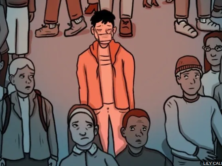
MURDER HE WROTE? Yours truly, Rhonda R. Shearer as depicted in Science magazine, alongside, former Papua New Guinea (PNG) World Wildlife Fund employee and indigenous person Daniel Wemp. Jared Diamond claims in his dramatic tale published by The New Yorker last year, that Wemp was a blood "thirsty" "killer" responsible for organizing "about 30 killings" during 1992-1995 -- an account for which Wemp served as his sole, unverified source.
The cardinal journalistic value cited in the SPJ code requires that all the indigenous individuals Diamond named as criminals be contacted before publication. The code states: “Diligently seek out subjects of news stories to give them the opportunity to respond to allegations of wrongdoing.”
Diamond told Balter that he left all that up to Wemp. And yet, Wemp had no idea, as Diamond himself admits, that there would be a New Yorker story naming him and others as being connected to heinous crimes.
Balter wrote that Diamond “did not try to get permission from [Isum] Mandingo and the others.” He quotes Diamond: “I trusted Daniel’s judgment about what was appropriate to discuss.” Diamond’s abdication of responsibility to contact people he plans to name as murderers and rapists is a clear departure from what he claims as his “good journalistic practice.”
Here are the quotations from Diamond’s piece, whose odd numbers suggest precision. Diamond writes in his New Yorker essay (emphasis mine) that “seventeen other men had been killed” in the years before the alleged 3-year war. He goes on the say “it took three years, twenty-nine more killings…before Daniel succeeded in discharging this responsibility.” Later he writes, “In total, about thirty people were killed in those six battles.” It all sounds so real. In fact, the use of odd numbers like 17 and 29 killed suggest a precision in the research. But the truth is that this “war” did not last three years and it did not involve six battles that killed 17 or 29 people. Four people were killed in three months of fighting in 1993. We verified these facts with dozens of people, including police, missionaries, tribal members (from both sides) and government officials.






